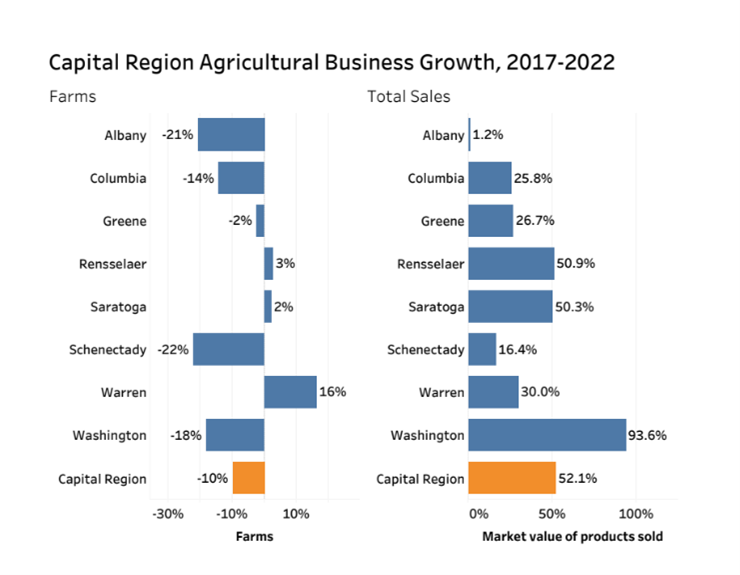Capital Region Generates More Agricultural Sales with Fewer Farms
The Capital Region’s agricultural footprint shrunk over the last six years, though the amount of labor hired by farms remained stable and total sales increased significantly, especially in the equine, fruit and dairy markets, according to a Center for Economic Growth (CEG) analysis of the U.S. Department of Agriculture’s 2022 Agricultural Census.
In 2022, the eight-county Capital Region had 3,068 farms with 522,794 acres of farmland. Compared to the USDA’s last census in 2017, that represented a 9.9 percent decline in farms and a 6.8 percent decrease in farmland. However, over that six-year period, the market value of agricultural products sold, or total sales, in the region increased by 52.1 percent to $633.4 million.

Producers and Workers
The region’s ranks of producers, also known as farmers, increased over the six-year period by 0.8 percent to 6,116. The number of women producers increased by 0.3 percent to 2,501 and the number of male farmers declined by 1.4 percent to 3,615. In 2022 there were 870 farms that hired workers, down 13.3 percent from 2017. Despite that decline in employer farms, the total number of hired workers declined by only 0.6 percent to 5,424.
Ag Census Quick Takes by County (2017-2022 Changes)
Albany: Maple syrup sales increased 296.3 percent to $107,000.
Columbia: The inventory of egg-laying birds (“layers”) in the county increased by 15-fold to 141,959 in 2022, compared to 9,359 in 2017.
Greene: The inventory of cattle and calves in the county increased by 94.1 percent to 5,109.
Rensselaer: Even though the volume of horse sales declined by 23.3 percent to 69, the value from those sales increased by 1987.9 percent to $2.8 million.
Saratoga: Total sales from fruits and tree nuts ($11.8 million) surpassed horse sales ($11.2 million)
Schenectady: Sales from fruits and tree nuts increased by 715.4 percent to $102,000.
Warren: The inventory of layers in the county increased by 59.3 percent to 1,246.
Washington: The inventory of milk cows increased by 7,533 to 30,511 – the second-largest gain in milk cows in New York, trailing Clinton County’s increase of 7,540.
Hot Ag Products
Agricultural product sales varied across Capital Region counties. Sales growth was strongest in Washington County, which increased over the six years by 93.6 percent to $263 million. It was followed by Rensselaer County at 50.9 percent to $61.9 million and Saratoga County at 50.3 percent to $115.5 million.
Examples of strong agricultural product growth in specific counties include:
Milk from cows
Rensselaer: up 85.3 percent to $14 million
Washington: up 118 percent to $95.3 million
Poultry and eggs
Columbia: up 1264 percent to $7.4 million
Washington: up 195 percent to $1.2 million
Equine (horses, ponies, mules, burros, and donkeys)
Rensselaer: up 1,787.7 percent to $2.8 million
Saratoga: up 154.7 percent to $11.2 million
Fruit and tree nuts
Columbia: up 70.3 percent to $25.4 million
Greene: up 626.3 percent to $1.9 million
Saratoga: up 249.9 percent to $11.8 million
Maple Syrup
Albany: up 296.3 percent to $107,000
Columbia: up 128.1 percent to $422,000
CEG Initiatives
To support the growth of the Capital Region’s agricultural economy, CEG is involved in the following activities:
Highlighting the Capital Region’s rural communities and farms through the CapNY initiative.
Providing technical assistance to local agriculture-related manufacturers, such as cheese makers and breweries, to help them operate more efficiently, tap new markets and grow in the region.
Don’t miss these insights into the trends that are shaping the Capital Region’s economy.
Sign up for CEG’s e-news and follow us on:














